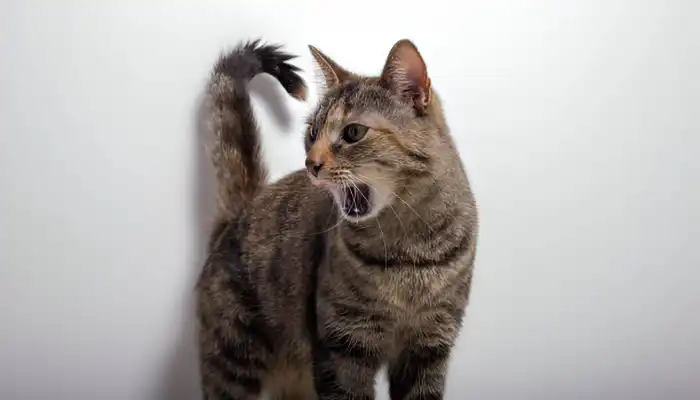How do I say “I hate you” in cat translator? Have you ever thought of if a cat can say “I hate you”? If so, then you are not the only one! Have you heard of cat translator? These devices and applications try their best to transform your cat’s sounds and movements into human language.
It’s amusing while it lasts, but these gadgets are still in development, so they are underestimating the meaning of cats too often. Technology should help you to understand your cat’s feelings, but it needs to be a little more advanced than this! Let’s dig deeper into your cat’s psyche.

What Is A Cat Translator?
Let’s first understand what a cat translator actually is before we discuss whether your cat can say “I hate you.”.
How Do I Say “I Hate You” in Cat Translator? A cat translator is a gadget or application built to convert cat vocalizations, meows, and body movements into human speech. Such devices cannot always accurately translate each purr or hiss, but they make an effort to translate the communication that your cat is trying to convey. But is it possible to translate hate? Let’s find out.
- Popular Devices & Apps:
- MeowTalk: A mobile application that claims to convert cat noises into human speech.
- Catterbox: A collar device that tries to translate your cat’s meows into something understandable.
- How They Work: These gadgets pay attention to the cats’ sound frequency, tone, and pattern to make sense of their meows.
Does It Really Work?
- The development of these translators is still a work in progress. While it’s entertaining, do not expect perfect translations on the first use. Cats have distinct ways of communicating, and what you think might sound like “I hate you” could just be a cat asking for food.
Cat translators are still evolving, offering a fun way to interpret your cat’s sounds and movements, but they aren’t perfect.
While they may help, understanding your cat’s emotions requires more than just a gadget—it’s about paying attention to their behavior and body language.
Can Cats Show Negative Feelings?
First, let’s explore how cats exhibit negative emotions before jumping to conclusions. So, is it possible for your cat to say, ‘I hate you’ with their behavior?
Cats express their emotions largely through body language, vocalizations, and behavioral actions. Although they are unable to vocalize hatred, cats give humans plenty of signs that show they are not fond of several things—like you.
So, How do I say “I hate you” in cat translator? While cats can’t say those words, their behavior speaks volumes.
- Common Signs Cats Exhibit When They Don’t Want to Be Bothered:
- Growling or Hissing: Your cat becomes angry and feels threatened when they start to growl or hiss.
- Ears Back: A less desirable scenario is when a cat’s ears are flat against their head, indicating that they are unhappy.
- Tense Body: Feeling defensive can stem from a stiff body posture or a puffed-up tail.
In truth, cats are more likely to show discomfort or displeasure through behavioral actions rather than verbal communication.
Negative Feelings Expression Could Be:
- A feline scratching at you.
- Not making an effort to interact.
- Retreating to a different space.
Search Terms: do cats show hate, cat body language, cat anger signs
Cats may not say “I hate you,” but their body language and behaviors are clear indicators of negative feelings. Pay attention to their growls, hisses, and body postures to understand when they’re not happy.
In What Ways Do Cats Express Their Emotions?
How do I say “I hate you” in cat translator? They do have other means of expressing such actions. Their body and head movements speak volumes, and you just need to learn their lingo. It is possible to figure out why a cat is upset by listening to their vocalizations and paying attention to their body movements.
Here’s a breakdown of how your cat might communicate with you when they’re not in the mood to express love towards you:
1. Sounds
- Meow: Some cats tend to meow to get the attention of their owners, while others may do it out of annoyance.
- Hiss & Growl: If you hear your cat making these sounds, know that they feel angry or they are being annoyed.
2. Non-verbal communication
- Tail Position: A cat with a straight leg up usually indicates a happy kitty, but when the tail is twitching, the feline could be annoyed.
- Pawing You: This indicates they do not want to be pets.
3. Changing Face Expressions
- Eyes Open: A highly frightened or angry cat may open their eyes wide and dilate their pupils.
| Vocalization | Emotion |
|---|---|
| Meowing | Hunger, Attention Seeking |
| Hissing/Spitting | Fear, Anger |
| Growling | Discomfort, Annoyance |
Not really. If you’re at the grocery store, this phrase can show your emotions because when you hate something, your body language reveals that unhappiness. How do I say “I hate you” in cat translator? The answer is simple: hatred is too abstract of a feeling for any device to comprehend, as it can’t be understood by all life forms.
The catch is:
- Comparisons between humans and felines are not straightforward, as some people are jealous of pets; therefore, one has to keep track of their dislike as well as anger.
- Cats aren’t the best at translating. Whether it’s with a meow, hiss, or any other noise, everyone gets the phrase “I hate you” wrong. Most electronic devices translate sound to tone, and that doesn’t funk up the meaning at all.
Did you know: While cats won’t claim “I hate you,” they sure do know how to show when they’re annoyed. And hey, they’ll make sure you’re well aware too.
General Tips for Cat Training:
- If your cat swats at you, it is best to give them a proper amount of playtime to alleviate their boredom.
- In case your cat is skipping you, perhaps try using some of their snacks or toys to reel them back in.
While cats may not say “I hate you,” their actions and body language speak volumes. By paying attention to their vocalizations, tail positions, and facial expressions, you can easily understand when your cat is upset or annoyed.
Conclusion
How do I say “I hate you” in cat translator? While there is no doubt that cat translators can help ease communication between humans and pets, remember that cats speak through actions and body language rather than words.
Devices like MeowTalk and Chatterbox may provide some insight into your cat’s emotions, but there’s still a long way to go in accurately deciphering feelings such as hate. From undertaking the task of deciphering your feline friend’s behavior and actions to building a stronger bond with them, that is what matters most.
